Working with Units
This section explains the following:
- selecting a standard system
- specifying the default units
- defining your own units
- entering mixed units
- copying the properties of units
- cyclic time units
Selecting a Standard System
There are two primary units systems available for selection in Simcenter STAR-CCM+:
- Systeme Internationale (SI), which includes meter, kilogram and second; and
- United States Common System (USCS), which includes foot, pound and second.
To set the SI or USCS systems as your preferred system, simply select it in the Units node in the Tools node:
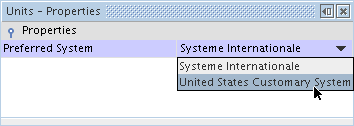
What happens when you change the system of units is that Simcenter STAR-CCM+ runs through all the units and sets the preferred ones to be the SI or USCS selection.
Keep in mind that any time a new preferred unit is selected it will reset the units everywhere in the system to that new value. Thus, it will reset any manual overrides you may have set in specific quantities.
Specifying the Default Units
You can specify which system and unit Simcenter STAR-CCM+ uses as its default for every new simulation.
- Either:
- Select a standard system. See Selecting a Standard System.
- Set a preferred unit. See Unit Node Properties.
- Right-click the
Units manager node in the
Tools node and select
Save as Defaults.
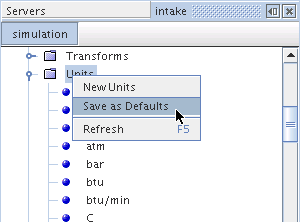
Your defaults will be applied when a new simulation is created.
Defining Your Own Units
It is easy to create a new custom unit. You will give this unit a certain set of dimensions and conversion information, and then you can use the unit anywhere a quantity with those dimensions is used.
| Note | Although Unicode characters (such as µ) can be used for naming user-defined units, they have limited support with functions. Units with such characters cannot be entered in expression fields directly, but can be used in constants within expressions (via < and > operators). For functions that allow specification of both dimensions and units, user-defined units with Unicode characters can be selected from the drop down list. |
Unicode characters (such as µ) are not currently supported by our expression parser, but can be used in naming of user defined units. User defined units using Unicode characters can be used in some expression fields (value function based ones that allow specification of units from a drop down list), but cannot be entered in the expression field directly. Field Functions do not support units (only dimensions), and can only utilize units with constants within expressions (via < and > operators), and thus cannot support units with Unicode characters in any capacity.
- Right-click the node and select . This will result in a new blank unit:
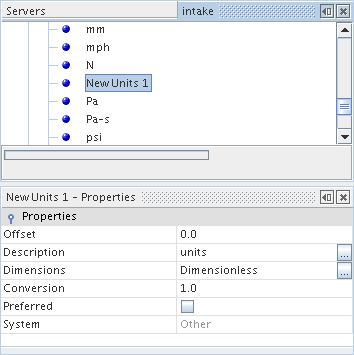
- Rename the unit.
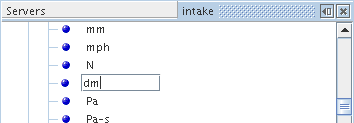
- Click the property customizer button (
 ) of the
Dimensions property to set the dimensions.
In this case the dimensions are length, so the length dimension exponent should be set to 1.
) of the
Dimensions property to set the dimensions.
In this case the dimensions are length, so the length dimension exponent should be set to 1.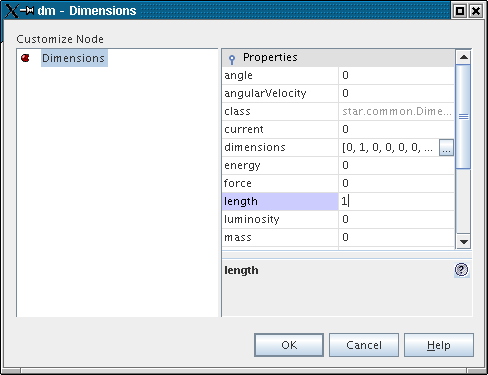
- Click OK
- Set the
Conversion and
Description properties for the new unit:
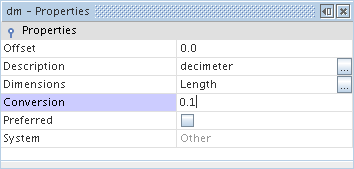
You can now use this unit anywhere a quantity with dimensions of length is required.
Entering Mixed Units
You can enter mixed unit strings into coordinate editor panel fields or properties.
Including commas between items is irrelevant, as long as there are spaces separating each item from its neighbor. For example:
- [2, 0.2222, 6] in yd ft
- [3 2.4 0.001] in cm m
Copying Properties of Units
When properties are copied from one unit to another, all of the properties other than System are applied.
It is not possible to copy properties between built-in and user-defined units.
Cyclic Time Units
Cyclic Time Units allow you to create new units for Time that are specified as angles with respect to a defined rotational speed.
- Right-click node and select.

The following image shows the Cyclic Time Unit (CT) node and the Cyclic Time Unit properties window:
Once a Cyclic Time Unit has been created, it can be used in any input that accepts time values, such as an unsteady time step size. Further, this creates three reports for each cyclic time unit in order to allow access and monitoring of Cyclic Time, Cumulative Cyclic Time, and the Current Cycle Number.